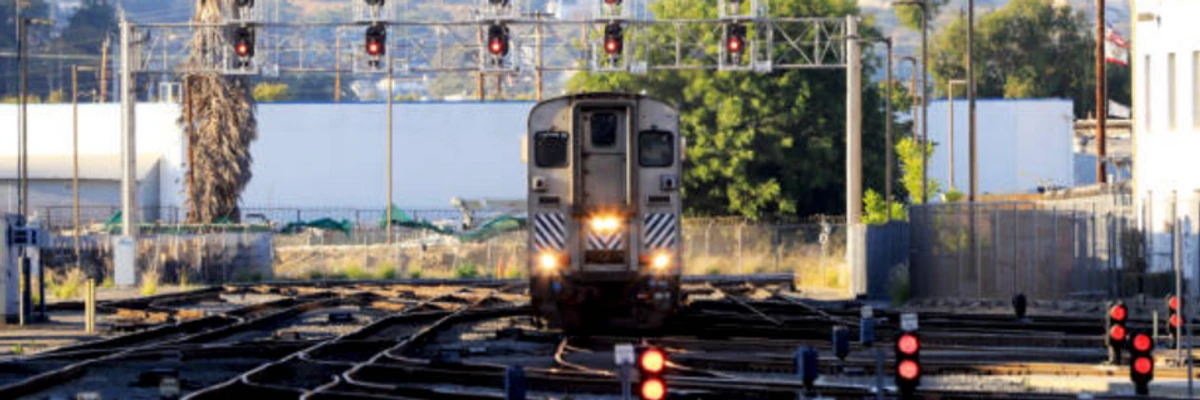From Margins to Growth
The Economic Case for a Public Rail System
The structure of the railroad industry in the United States constitutes a massive and ongoing missed opportunity. Freight service is in decline, and passenger service lags enormously behind international peers. Long-term trends of decreased freight service, decreased market share, and decreased employment have accelerated in recent years, particularly with the advent of precision-scheduled railroading (PSR) across most Class 1 railroads. In many ways, these are predictable consequences of how the industry is structured: as a set of massive, largely underregulated, regional duopolies.
Oligopolistic industries, particularly in the absence of effective and enforced regulations, will tend to collude to control prices; decrease service to accept only the most profitable customers; and scale back investment, employment, and capacity to accommodate the strategy of pursuing only the highest margin customers. Trends that are abundantly clear in the data and in accounts from industry stakeholders, including private shippers and passenger associations, outline in countless ways these predictable consequences of the industry’s structure. This focus on margins has also led the industry to an overreliance on specific commodities, especially coal, that set the industry up for further, more precipitous decline, as shipped coal volumes are set to steeply fall in the near future.
In conjunction with massive subsidies for on-road and air transportation relative to rail, oligopolistic conditions lead to a marked underutilization of rail for both freight and passenger service. The American public and the American economy suffer as a result. Different modes of transportation have different financial costs to users and pose different levels of external costs to the public. Where financial and social costs can be quantified and compared across modes, rail tends to have far lower public and private costs than on-road transportation or air travel. For freight, rail tends to be three to five times cheaper per ton-mile compared to trucking. Trucking generates eight times as much greenhouse gas (GHG) pollution, kills six times as many people in crashes, injures 14 times as many people, and generates three times as much non-carbon air pollution for moving the same tonnage the same distance. Trucking also creates congestion on roads and highways and contributes to their deterioration. These large costs of time, money, and shortened lifespans are offloaded from the trucking industry onto others. For passenger travel, movement by cars, pickups, or SUVs causes 27 times more deaths and 160 times more injuries from crashes relative to diesel rail and creates five times as much GHG pollution for moving the same number of people the same distance. Air travel generates five to six times more carbon pollution than diesel rail per passenger-mile traveled while also contributing substantially to climate change through other, nonemission effects. While rail is already more climate friendly than these other modes of transportation when powered by diesel fuel, it is also far easier to decarbonize entirely.
Meanwhile, cost savings from shipping would help consumers, reduce prices, and improve US export competitiveness for key sectors. Shipping comprises a substantial portion of product costs, often accounting for 10% of product prices, but this share is estimated to reach as high as 40% for some agricultural commodities. 1 Given that rail can achieve much greater cost effectiveness compared to trucking—even while trucking is currently so highly subsidized in comparison—improved coverage and quality of rail service is a potentially enormously powerful lever to reduce prices for US consumers and costs for US businesses, especially those in agriculture, manufacturing, and other sectors that produce and move physical products. Conversely, when underregulated oligopolistic conditions and vastly unequal levels of public investment and subsidies push traffic from rail to trucks, the costs to society, the economy, businesses, and consumers all grow enormously.
The primary goals of this report are to quantitatively assess the extent and costs of this underprovision of rail in the US and evaluate the feasibility of public rail ownership to help reverse course. This report introduces new modeling on mode shift potentials for both freight and passenger travel, catalogs private and public costs across modes, and uses modeled mode shift scenarios to calculate the scope of potential benefits realizable from mode shift. A study of the industry structure in the US and a comparative analysis of historical and international rail institutions establish the role public ownership and other reforms could play in achieving modeled mode shifts.
Mode shift scenarios are constructed from historical trends and forecasted travel patterns for both freight and passenger movement. For freight, mode shift scenarios envision reversing prior shifts from rail to truck, bringing the majority of long-distance truck freight onto rail, and shifting back to rail substantial portions of agricultural and other commodities that are already well-suited for rail. For passenger travel, mode shift scenarios are constructed from national household travel data, with a portion of intercity trips shifted from on-road transportation to rail for the moderate scenario. The ambitious scenario also imagines a new build out of high-speed rail (HSR) that shifts some passenger travel from air to rail.
Combined with the differential costs by mode, the modeled scenarios allow estimates for the scope of potential benefits from mode shift. In short, the scope of benefits would be huge. The ambitious mode shift scenario modeled in this report shows that, by 2050, the US could save up to $400 billion annually on shipping costs; avert over $190 billion annually in averted public health, environmental, and fiscal costs; create 180 thousand new jobs in the railroad sector; and create up to four million other new jobs throughout the economy through indirect economic effects. These would be in addition to a range of other benefits that are not quantified in this report.
…the US stands to avert over $190 billion in public health, environmental, and fiscal costs; save up to $400 billion annually on shipping costs; create 180,000 new jobs in the railroad sector; and create up to four million other new jobs throughout the economy through indirect effects.
The estimated $190 billion in annual averted public health, environmental, and fiscal costs breaks down across GHG emissions, other forms of air pollution (particulate matter [PM2.5] and nitrogen oxides [NOx]), crash deaths and injuries, road wear and tear, and traffic congestion. While new jobs in the railroad sector are likely to be offset or partially offset by fewer jobs in trucking, the vast majority of jobs created from this shift would be due to decreased shipping costs from rail, which would spur employment in a wide range of industries without declines elsewhere. The combined benefits from decreased shipping costs and averted social costs here amount to nearly $600 billion annually by 2050—a sum equal to 2% of US gross domestic product (GDP) in 2022. For additional context, many estimates put the total fiscal cost of the Inflation Reduction Act (IRA) at around $100 billion per year, meaning that if rail service is improved and expanded in the US, the IRA could be paid for four times over by 2050 from shipping savings alone.
By 2050, the total GHG emissions averted through the mode shift to rail would reach nearly 5,000 million metric tons of carbon dioxide equivalent (MMT CO2e) — equivalent to 2% of the world’s remaining carbon budget to maintain a 50% chance of staying within 1.5°C of warming.
Not only does public ownership have the potential to trigger a mode shift that would spur economic growth and deliver benefits to the public in the form of improved health and safety, time savings, and reduced shipping costs, this mode shift is also essential to reaching global climate emission targets. On its own, the average annual emissions reductions from mode shift to rail estimated here would cut 1/10 from current transportation sector emissions. By 2050, the total GHG emissions averted through mode shift to rail would reach nearly 5,000 million metric tons of carbon dioxide equivalent (MMT CO2e)—equivalent to 2% of the world’s remaining carbon budget to maintain a 50% chance of staying within 1.5°C of warming. The transportation sector is currently the largest source of GHG emissions in the US and is seeing the slowest progress in decarbonization. Decreasing emissions in this sector by 10% would therefore constitute a major step toward decarbonization.
These economic, social, and climate benefits are realizable by reversing current trends of decline in rail freight while also meaningfully expanding passenger service. But changing railroads’ current trajectory will necessitate deep changes to the structures that currently shape the industry. Public rail ownership provides a direct and decisive path from the current structure as a set of large, underregulated duopolies to a cohesive entity, well-positioned to reverse decades of decline and worsening service.
International and historical examples, as well as existing lines in the US, establish the potential for publicly owned and operated rail lines to vastly improve service and utilization. Within the US, publicly owned passenger lines account for a huge proportion of total rail passenger-miles traveled (PMT) and see far greater investments in improved service and decarbonization compared to routes that run on primarily privately owned rail tracks. Internationally, many countries around the world with mostly public rail operations have seen consistent, excellent results. Direct comparisons of rail mode shares across countries should be made with caution, because other factors also dramatically affect mode share and large variation exists in railroad governance even within systems that are predominately public or predominantly private. However, countries with publicly operated rail lines tend to have more intensely used rail systems, even when geography or dominant shipped commodities are less favorable to rail. Examples of countries with successful, primarily publicly owned rail systems include Switzerland, Austria, Ukraine, Germany, France, China, South Korea, and India.
While increasing the number of rail operators, to increase competition, may seem to be an intuitive solution to the oligopolistic conditions that currently characterize the sector, international precedents and empirical research caution against this approach. In both public and private systems, fragmentation of rail ownership and operation tends to increase complexity and reduce transparency: hindering efforts to modernize, obscuring responsibility when things go poorly, and inducing economic and financial costs.
Institutions for rail system governance can have tremendous variation. Ownership and operation of rail lines may be managed by a single entity or split across multiple entities, which may be public, private, or a mixture of both. While in-depth plans on how public ownership should be implemented is not the focus of this report, a comparative analysis of railroad institutions and international practices indicate the promise of public ownership, particularly when paired with integrated public operation. As a whole, the findings in this report highlight the urgency of investing in rail—and dramatically altering the institutions that have undergirded rail’s decline and underuse for decades.

